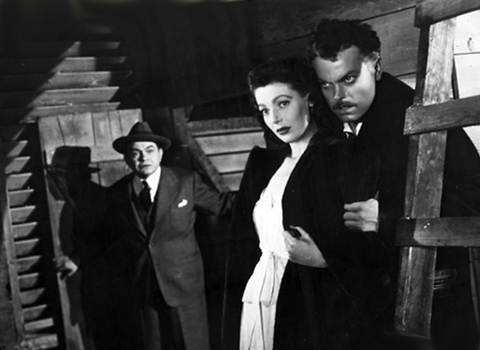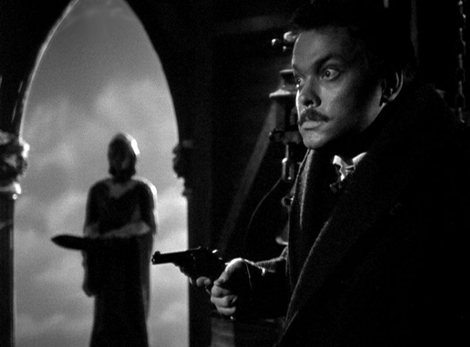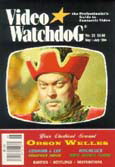Reviewed by Glenn Erickson
Kino Classics has been issuing a series of Blu-rays of Public Domain features for which good source elements can be found and HD versions remastered. The latest is a genuine classic, Orson Welles' 1946 The Stranger. A reasonably good non-PD DVD version was released by MGM in 2007. Kino's disc sweetens the deal with a couple of very impressive extras.

Originally released by RKO, The Stranger is a postwar anti-Fascist movie of a kind that Cold War politics would soon make disappear. Anthony Veiller's screenplay emphasizes the persistence of the Nazi threat beyond the Allied victory. The thrillers Cornered, Notorious and Gilda also involved ex-Nazis reforming a possible new Reich in Latin America; but in just a year the entire hot-button subject would be abandoned as the U.S.A. geared its propaganda machine to oppose the looming Communist threat. Although rumors abounded of high-ranking Nazis recruited by new American intelligence agencies, movies about a possible new Fourth Reich vanished. In 1950, a finished RKO film called The Man He Found was partially re-shot to turn an evil Nazi conspiracy into an evil Commie conspiracy. Hitler was out, Ivan was in. The movie was re-titled The Whip Hand. Its producer Stanley Rubin asked to have his name removed.
Orson Welles reportedly took on The Stranger to prove that he could make a popular thriller without production complications, to show Hollywood that he was neither difficult to work with nor an irresponsible spendthrift. The film was a financial success, and some say the only Welles picture to turn a profit when new.
The suspenseful story is about the cornering of a Nazi monster, not somewhere in Europe or South America but in an idyllic American college town. Nazi mass-murder architect Franz Kindler is unaccounted for, and to track him down U.S. special agent "Mr. Wilson" (Edward G. Robinson) frees an imprisoned underling, Konrad Meinike (Konstantin Shayne). Wilson tracks Meinike through Latin America and then to Harper, Connecticut, where the trail suddenly stops. Wilson suspects new citizen Professor Charles Rankin (Orson Welles) until Rankin makes an anti-Fascist speech at a dinner party. But Rankin's new wife Mary (Loretta Young) becomes upset when first her dog and Meineke turn up dead. Rankin soothes Mary with a claim that he is being blackmailed. Wilson must persuade her to accept the fact that her husband is not a romantic with problems, but a dangerous escaped war criminal.
The Stranger is an efficient and impressive production directed by Orson Welles for maximum suspense. He's also quite good as the lead villain, building Charles Rankin / Franz Kindler into a complex character with several levels of secrets to hide. The audience-pleasing comeuppance conclusion doesn't overdo some bizarre dramatic effects.

According to a fascinating article that appeared in an early issue of Video Watchdog 1, Welles filmed and cut a much longer prologue depicting a trail of intrigue and murders as the sinister Konrad Meineke makes his way to America. Perhaps intended to sell the idea that our South American 'good neighbors' were also intent on capturing fugitive Nazis, the prologue isn't really missed. The existing cut wastes no time geting us to Connecticut, and establishing secret agent Robinson's crusade to catch his quarry.
The script divides most of its time between three Harper locations. At the old-fashioned cracker-barrel general store, Billy House's portly Mr. Potter plays checkers, keeps tabs on all who come and go and in general refuses to move unless absolutely necessary. The New Englanders are scrupulously honest and proud of it. Potter won't open Meineke's abandoned suitcase without a witness, and at one point Mary tells us that she's perfectly safe walking home in the dark because, "This is Harper."
Mary is proud that her father, an ex- Supreme Court Justice, represents good Liberal America -- in fact, Rankin uses those exact words. Wilson finds a friend and early ally in Mary's idealistic brother Noah (Richard Long), and together they link Meineke's fate to the slippery Rankin.
The real drama takes place at Rankin's house, where the wholesome Mary denies as long as possible the awful truth that she's married a monster. Rankin is more subtle than earlier Nazi stereotypes. In the wartime film The Master Race hidden SS fugitive George Coulouris is prone to spout forth with vicious, unprovoked Nazi rhetoric. Welles has Rankin initially hide behind a meek disguise. He shows his true colors only when he inadvertently corrects Wilson in a casual conversation, saying that Karl Marx was not a German but a Jew. Rankin assures Meineke that a new Reich can and will be rebuilt, but even when cornered spares us the usual rabid rhetoric. The sharp oratory is instead given to Edward G. Robinson's highly motivated Nazi hunter ... another humble move by a director often accused of reserving 'all the good bits' for himself.

Rankin is capable of poisoning a dog, strangling a man and even setting up his new bride for a fatal fall. Welles reserves his baroque touches for a tall church tower with a somewhat out-of-place Old World clock, the kind with large animated figures. For Rankin / Kindler, restoring the broken clock probably represents getting the gears of the Nazi mechanism working in this new, unsuspecting country. The clock tower becomes the stage for risky confrontations and Kindler's last stand.
Welles works well with his small cast, finding a bit for his old Mercury Theater actor Erskine Sanford at a dinner party. Russell Metty's camerawork is sharp and unfussy. The original story is by Victor Trivas, a German who would later return to his home country to make the rare surgical horror film Die nackte und der satan (The Head).
Kino's Blu-ray of The Stranger was sourced from "archival 35mm elements preserved in the Library of Congress." The image on view is reasonably sharp but shows heavy wear. Fine scratches crop up frequently, and a larger scratch on the right side of the image is present for most of the last reel. At several points the action jumps forward a few frames, presumably where film damage was removed. Although very watchable and far, far better than a mushy-looking earlier Blu-ray, the transfer has contrast issues. Light scenes lose detail, as do some facial close-ups. The town of Harper seems to be in the heat of summer, but everyone is wearing coats.
MGM holds the original printing elements for The Stranger. Ten years ago it released very good DVD encodings of this title and another that has likewise been replicated to death on countless battered Public Domain releases, the film noir He Walked By Night. If MGM were interested in promoting its Public Domain holdings, they could easily produce a superior Blu-ray. As it is, they may have decided that the earlier DVD releases were a mistake -- subsequent Public Domain discs of He Walked by Night have simply ripped off MGM's superior DVD.
Kino's Blu-ray is better than acceptable, just the same. Where the release excels is in its extras. In addition to an original trailer and an image gallery, Kino house producer Bret Wood provides an extremely insightful and well-informed full commentary. He then goes a step further to include four complete radio programs in which Orson Welles uses his entertainment format to dispense wartime morale propaganda. Three of the shows are from 1942. Welles opines on the Nazi plans for Canada, on the war effort in our factories and about America's 'good neighbor' relationship with Brazil. The fourth radio show from 1946 is a dramatized talk about the Bikini Atom Test, performed as if Orson were on-site and awaiting the detonation.
The final extra is one of the 'forbidden' pictures of the post-war era. Death Mills was compiled by Billy Wilder to be used in forced screenings for the German public after the war. It's a collection of the grisliest and most damning footage from the Nazi death camps, with nothing edited out. A few 'safe' shots from it were incorporated into The Stranger and we quickly recognize many other shots from other war docus. This original nightmare has material seen nowhere else, not even in the longer, harrowing Memories of the Camps compiled by Hitchcock for the English. One can dread what's coming when an opening title card reads: "This film is not to be shown to any audience without the permission of the War Department."
On a scale of Excellent, Good, Fair, and Poor,
The Stranger Blu-ray rates:
Movie: Excellent
Video: Good +/-
Sound: Excellent
Supplements: Commentary, trailer, stills, four Orson Welles radio shows, short subject Death Mills
Deaf and Hearing Impaired Friendly?
N0; Subtitles: None
Packaging: Keep case
Reviewed: September 30, 2013

Footnote:
1. The May/June 1994 issue of Video Watchdog, to be exact, #23. The author was Bret Wood, Kino's disc producer on this Blu-ray release. It was one of the articles that made VW essential reading.
Return

DVD Savant Text © Copyright 2013 Glenn Erickson
See more exclusive reviews on the Savant Main Page.
Reviews on the Savant main site have additional credits information and are often updated and annotated with reader input and graphics.
Also, don't forget the
2011 Savant Wish List.
T'was Ever Thus.
Return to Top of Page
|


